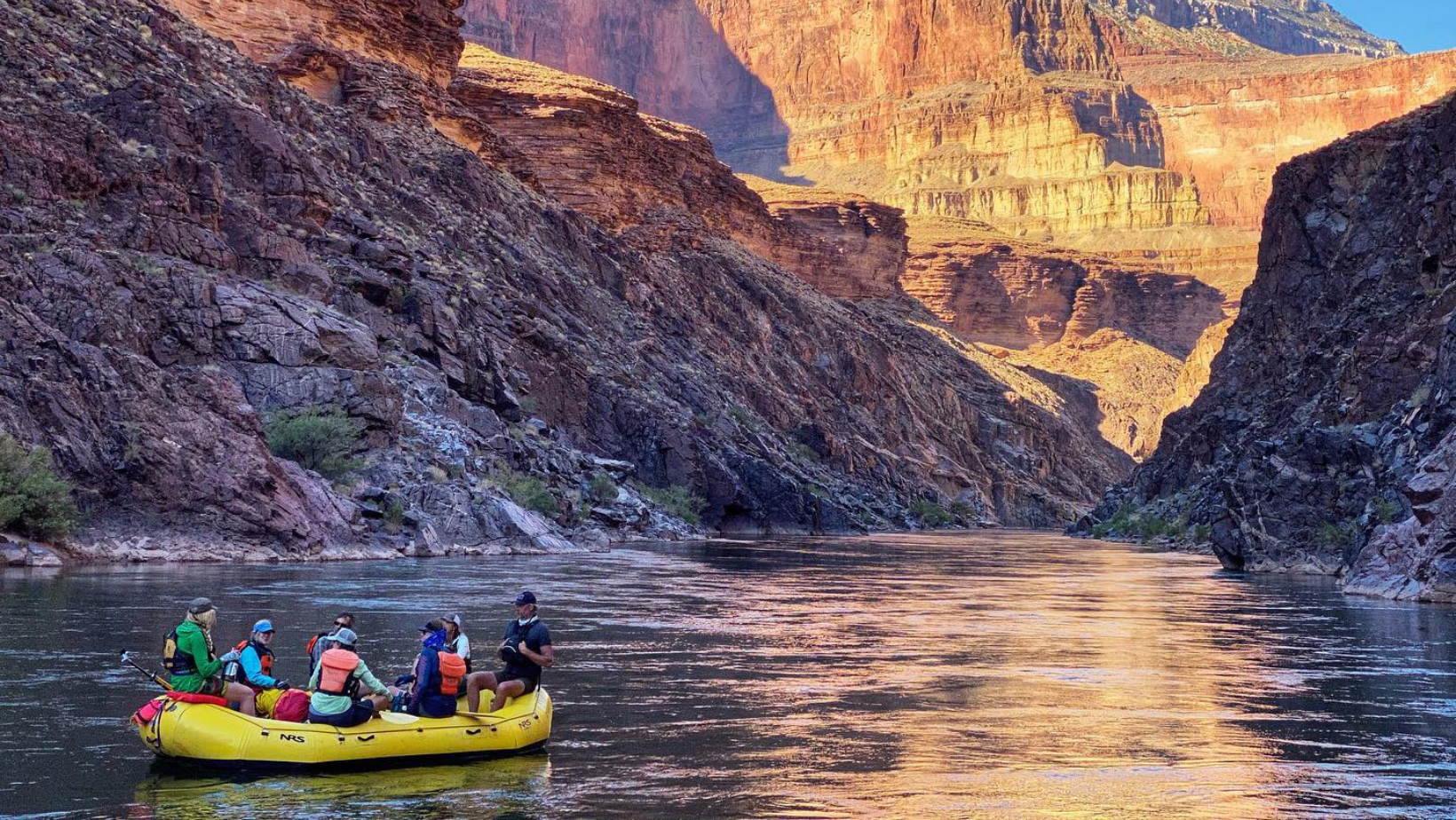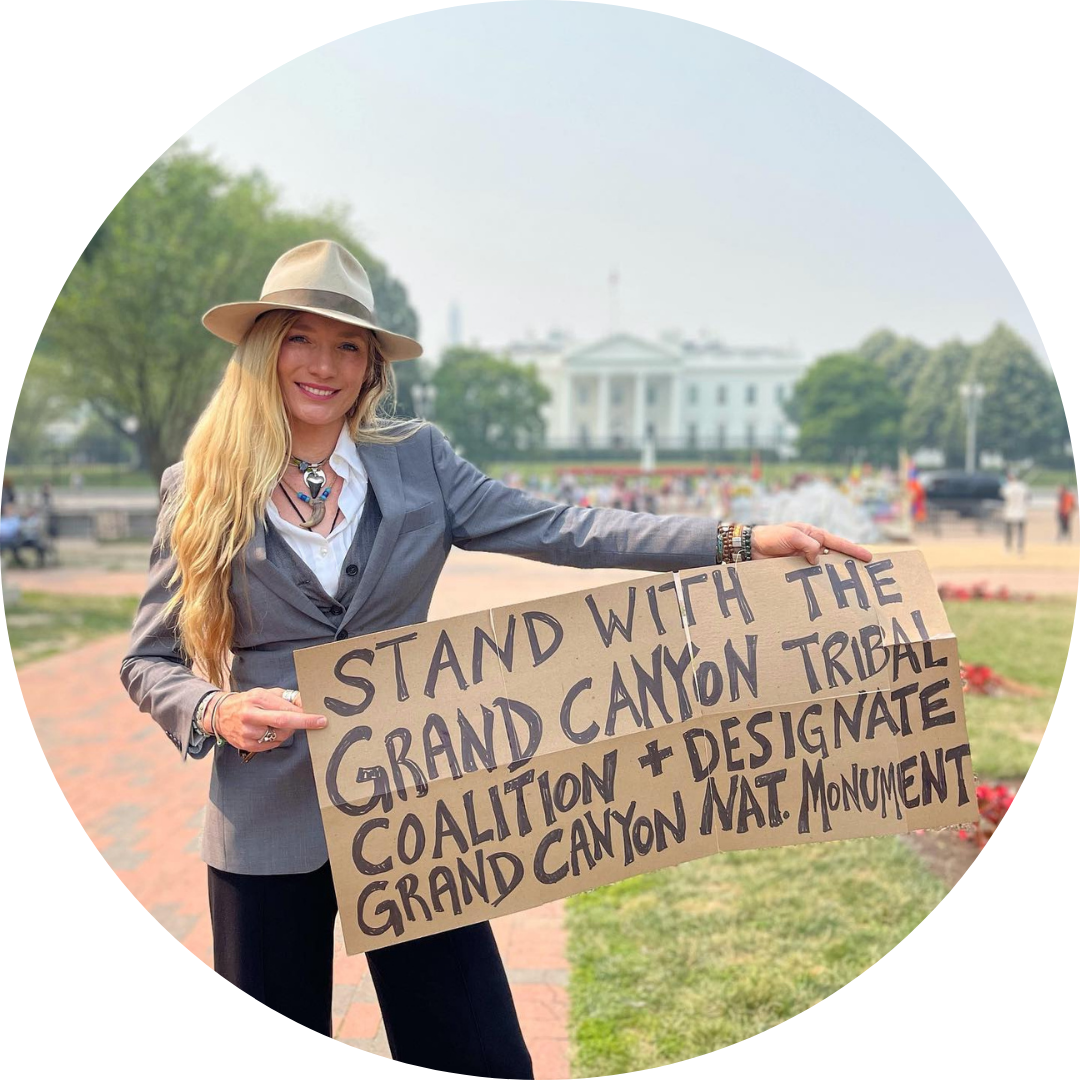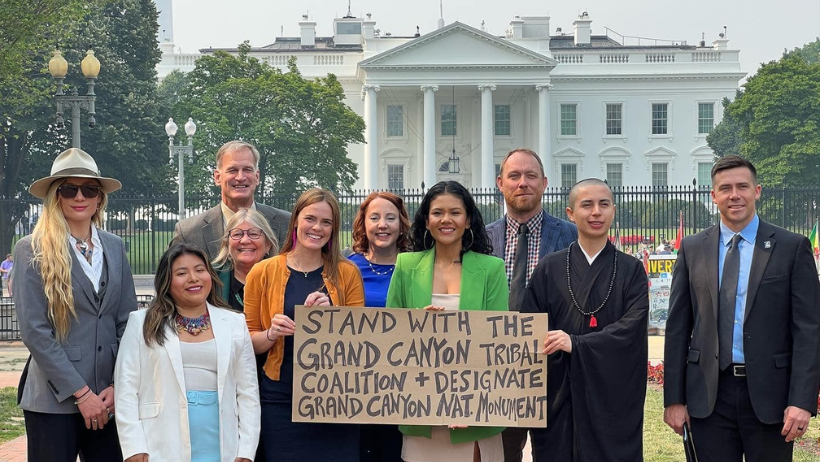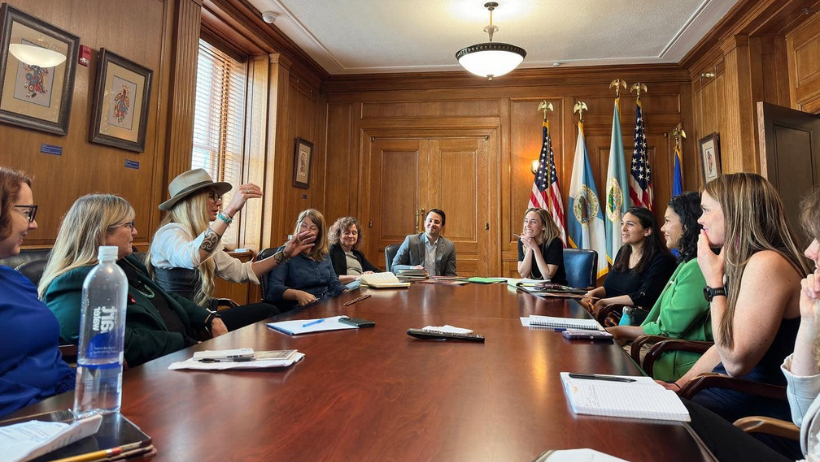

Author: Mandela van Eeden
Mandela is an educator and conservationist who guides in Africa, New Zealand, Alaska, Idaho, and the Grand Canyon. She is passionate and actively involved with conservation issues on every continent. She does this both professionally and during her spare time on the board of directors for the Montana Wildlife Federation. You can connect with her via www.TrailLessTraveled.net, and listen to her podcast, “The Trail Less Traveled,” everywhere.
The decision to step away from guiding full-time in the Grand Canyon and play a larger role in protecting it has been a grand adventure. The transition from guiding 250 days a year to rowing a desk 40 hours a week for the National Wildlife Federation has been challenging yet equally rewarding. Joining the Grand Canyon Tribal Coalition and speaking at the White House felt pivotal for this life-changing decision and our collective efforts to permanently protect critical lands, water supplies, wildlife, and cultural and religious sites.
On August 8, 2023, President Biden used the Antiquities Act to designate the Baaj Nwaavjo I’tah Kukveni – Ancestral Footprints of the Grand Canyon National Monument. The sun was high in the sky when he signed the proclamation and permanently protected nearly 1 million acres of public land surrounding our iconic National Park. Baaj Nwaavjo means “where tribes roam” in the Havasupai language and I’tah Kukveni means “our footprints” in Hopi.
In early June 2023, I joined my colleagues at the Arizona Wildlife Federation in Washington, D.C., for a fly-in with ten other conservationists. We met with the USDA, DOI, CEQ, and White House staff. We came on behalf of a much larger group of local elected officials, sporting groups, military veterans, recreationists, guides, conservationists, and local and national businesses. It was an honor to officially represent the Grand Canyon River Guides Association alongside Grand Canyon Trust, Trout Unlimited, HECHO, Chispa AZ, Coconino County, and the Arizona Faith Network. We each brought a unique perspective and had the opportunity to elaborate on why we felt strongly about permanent protections. My focus was on the recreational economics and springs hydrology of the Colorado River; I used science-based data, pictures, and tribal art to impress upon the audience the importance of protecting this landscape.. To exemplify one of the area’s many economic values, I shared that I have relied on my income from guiding for over a decade, as well as my first-hand knowledge of many small businesses associated with commercial river trips and outfitters.
After several days of back-to-back meetings, our coalition hit our stride when we spoke at the Department of the Interior. After I spoke, the DOI’s Deputy Chief of Staff for Policy said she wanted to go rafting with me. I smiled and promptly responded, “Yes, the rapids in the Grand Canyon are RAD, but the springs are the most important destinations we share with river runners, and if they get contaminated, it’s not feasible.” My river guide lingo produced a round of laughter as perhaps it was the first time the word “rad” had been used at the DOI. It was inspiring to sit in the White House while observing other U.S. citizens walking the corridors advocating for various issues. I hope all Americans realize that this doesn’t happen in every country and that participating in the legislative process is part of what makes a democracy.
“Congress shall make no law respecting an establishment of religion, or prohibiting the free exercise thereof, or abridging the freedom of speech, or of the press; or the right of the people peaceably to assemble, and to petition the Government for a redress of grievances.” First Amendment of the Constitution of the United States.

As river guides, we are incredibly privileged to run the river 1 to 14 times per year; but with privilege comes responsibility, and it is vital for us to prioritize awareness of existing and future threats to the Grand Canyon.
This National Monument designation will prevent new uranium mining on almost one million acres of land, protecting groundwater, air quality, and ancestral homelands. The Grand Canyon Tribal Coalition, which drew up the monument proposal, includes members of the Havasupai Tribe, Hopi Tribe, Hualapai Tribe, Kaibab Band of Paiute Indians, Las Vegas Tribe of Paiutes, Moapa Band of Paiute Indians, Paiute Indian Tribe of Utah, Shivwits Band of Paiutes, Navajo Nation, San Juan Southern Paiute Tribe, Yavapai-Apache Nation, Zuni Tribe, and the Colorado River Indian Tribes.
Arizona’s 18th National Monument includes Marble Canyon, the Echo and Vermilion Cliffs, and the Havasupai’s sacred “Wii’i Gdwiisa” (Red Butte) mountain. Prior to the forced restriction of the Tribe into their canyon in the 1800s, the Havasupai hunted and gathered during winter around Red Butte. This is the place of emergence for the Havasupai, and for them, is a lung of Grandmother Canyon. Today, Red Butte is federally recognized as a traditional cultural property, and the summit can be reached by a short but steep trail. Looking north from the top, you may see the Pinyon Plain Mine (also known as Canyon Mine). This uranium mine sits 10 miles from the South Rim on top of the deep Redwall-Muav Aquifer and shallower “perched” aquifers, which feed the seeps and springs in Havasu Canyon. This mine may eventually contaminate the deeper aquifer, which provides water for people, livestock, and crops in the village of Supai.
The Havasupai challenged Kaibab National Forest’s decision to approve the Pinyon Plain Mine in 1986, but they lost their appeal in federal court in 1991. As of today, the mine has resumed operations without revising or updating the original 1986 plan of operations. In 2016, the mine struck groundwater, and as a result, has pumped out over 49 million gallons of water contaminated with high levels of uranium and arsenic. The water is often “misted” into the air to speed up evaporation, but when it is windy, radioactive water reaches far into the surrounding National Forest. Unfortunately, the Pinyon Plain Mine can continue its operations because it’s subject to “valid existing rights,” meaning any mine or claim with VER is grandfathered in under the temporary or permanent mining ban. Pinyon Plain Mine is the only claim to get that determination of the nearly 600 claims that are preexisting.
Advocacy:

“We were given the responsibility to protect and preserve for those who are yet to come. We have a job to do. The rock writing tells us: protect this place, guard this place, this is your home.” - Rex Tilousi, Havasupai Elder.
In 2011, more than 200 Arizona small businesses addressed postcards to former Interior Secretary Ken Salazar. In 2012, Salazar finalized a 20-year mineral withdrawal for more than one million acres of BLM and U.S. Forest Service land to protect the Grand Canyon and its watershed from the potential adverse effects of additional uranium and other hard rock mining. Up until now, that mining withdrawal was temporary and at high risk of being overturned.
Native peoples have stewarded these lands since time immemorial and the Tribes have actively gathered, danced, and prayed for water and for future generations who will inherit this sacred ecosystem. As Grand Canyon river guides, it is our responsibility to continue this legacy of stewardship by being informed, engaged, and vocal with our guests and elected officials. The designation of Baaj Nwaavjo I’tah Kukveni – Ancestral Footprints of the Grand Canyon National Monument should make us feel empowered to take on the Big Canyon Dam proposal along the Little Colorado River. We can do this by supporting the work of the Little Colorado River Initiative and Save the Confluence as they actively work to change the Federal Energy Regulatory Commission’s (FERC) dam permitting rules to require tribal consent and consultation. Please make it a priority to raise awareness regarding current and future threats by urging your guests to advocate on behalf of the Grand Canyon.
Uranium:
Uranium mining in Arizona has taken place since 1918. The uranium market rebounded in the late 2000s, and a swarm of new uranium claims popped up in the greater Grand Canyon region. At best, only 1.3% of the nation’s total uranium supply occurs in the Grand Canyon region. To extract that 1.3%, mining companies would have expanded uranium mining at an unprecedented rate. There is 10-fold more uranium in Canada and 40-fold more in Australia, two friendly countries with which we trade.
One of the concerns of uranium mining from the breccia pipes on the surrounding plateaus has to do with tailings containment. Once removed from the ground, this material quickly oxidizes as it is exposed to air, making the uranium and daughter products more mobile in both surface water and the sediment it transports into surface drainages. This movement, especially in flash floods, is a major risk to the Havasupai Tribe because it sweeps through their village in Cataract Canyon. It also contaminates groundwater derived from Havasu Spring because the material recharges through open sinkholes along extensional-tectonic earth cracks that capture flows into the otherwise ephemeral Cataract Creek. From past flood experience, we know that it only takes about two years for these toxic compounds to reach Grand Canyon springs following flash flooding in Cataract Creek. This is a throughput contaminant transport rate of 20 miles through the karst conduits of the Redwall Formation in just 2 years.
National Monuments:
“The new protections will also safeguard important recreation areas so that future generations can to continue to hunt, fish, hike, and raft on the lands and waters that surround this great natural wonder.” -Scott Garlid, Arizona Wildlife Federation.
An Act for the Preservation of American Antiquities (Antiquities Act) was signed into law on June 8th, 1906. The Act was the first U.S. law to provide general legal protection of cultural and natural resources of historic or scientific interest on federal lands. Public lands receive monument designation after the president determines that they meet the prerequisites under the Antiquities Act and are areas that contain “historic landmarks, historic and prehistoric structures, and other objects of historic or scientific interest.” Over the past 117 years, seventeen U.S. Presidents (eight Republicans and nine Democrats) have declared over 140 national monuments under the Act.. Arizona has 18 National Monuments — all of which protect wildlife, land, and cultural and natural resources, and many of which ensure access for hunting, fishing, hiking, camping, cycling, and other outdoor recreational activities.
Teddy Roosevelt recognized this area for its world-renowned mule deer herd and would be pleased to hear that this monument prioritizes access for wildlife management and the heritage of hunting in the area.
Opponents of the National Monument argued that this designation would have reduced or eliminated grazing, hunting, and timber harvesting. National monuments are federally managed public lands and have the potential to enhance public access by limiting destructive land uses. Nonetheless, National Monuments are managed for “multiple uses” and allow a myriad of land and resource use activities.
Grand Canyon’s Groundwater, Springs, and Streams:
"For Hopi, it’s our place of emergence, a place that we still hold pilgrimages and offerings. It’s what we consider the heartbeat. Much like a human being, the waterways are arteries and veins carrying that lifeblood, not only to Arizona, but the entire world. It keeps life going. And if we poison that blood, life dies.” - Timothy Nuvangyaoma, chairman of the Hopi Tribe
As the planet continues to warm and dry, freshwater will become increasingly less available. Birds and other wildlife easily make their way through the Pinyon Plain mine’s fences to quench their thirst with uranium- and arsenic-contaminated water pumped from the shaft. According to the 2008 publication Aridland Springs in North America: Ecology and Conservation, desert springs like those in the Grand Canyon region often are “…biologically and culturally complex, highly individualistic, strongly ecotonal, and ecologically highly interactive, functioning as ‘keystone ecosystems’— small patches of habitat that play ecologically influential roles in adjacent landscapes.”
More than 500 abandoned uranium mines are scattered across the region, impacting freshwater sources for local populations and seeping contaminated water into the Colorado River and other water bodies over great distances. Springs are indicators of aquifer integrity. According to a recent U.S. Geological Survey report, 15 springs and five wells in Grand Canyon watersheds occur near uranium mines and have dissolved uranium concentrations that exceed safe drinking water standards. Both the ecological importance of springs as keystone ecosystems and the level of ecological impairment of springs are especially great in arid regions, with 70-90% of springs in the lands surrounding the Grand Canyon ecologically impaired or devastated.
"Our state is very dry and has few forests and (little) water. Whatever little we have left is special to everybody and must be protected." - Hernan Castro, ecologist with the Chiricahua Apache Nation.
Springs are hotspots of rare and unique biodiversity and are the most important recreation destinations in the Grand Canyon region. Despite their small overall habitat area (<0.001% of the nation’s land area), these groundwater-dependent ecosystems support more than 17% of the USA’s endangered species. Furthermore, most of the recent extinctions in the Southwest have involved springs-dependent species. Research has been conducted, yet we still do not know the full complexity and interconnectedness of below- and above-ground waters in the Grand Canyon region. But one thing is for sure, the water, life, ecology, and cultural integrity of the region are all connected.
The Economy:
"Protecting this area makes great economic sense. A National Monument extends our outdoor recreation focus and further enhances the tourism economy.” - Patrice Horstman, chair of the Coconino County Board of Supervisors.
The National Park Service reported that 4.5 million people visited Grand Canyon in 2021 spending an estimated $710 million in the gateway regions near the park. That visitation supported 9,390 jobs in the region. According to a 2021 Backcountry and River Use Statistics report, Grand Canyon River Guides take 19,000 to 24,000 people down the Colorado River each year. On an annual basis, this contributes $90-$120 million dollars to the Grand Canyon recreation economy.
The same distinctive hydrology and geology that created the grandeur of the Grand Canyon make this area particularly vulnerable to toxic uranium mining. Speaking up is utterly important to the conservation of our natural resources, its biodiversity, the economy of Northern Arizona, and all the communities and cultures that exist in the Colorado River basin.
In the birth of the modern environmental movement, the Sierra Club mobilized public opinion to stop dam construction in the Grand Canyon. Like those who wrote to the government then, the collective efforts of the Grand Canyon Tribal Coalition made their voices heard. YOUR VOICE MATTERS—use it.
Conservation is not a spectator sport. Let's celebrate the designation of Baaj Nwaavjo I’tah Kukveni – Ancestral Footprints of the Grand Canyon National Monument and continue to SPEAK UP in order to safeguard Indigenous communities, wildlife, critical habitat, and clean water in the Grand Canyon.
.png)